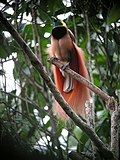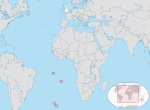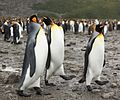The New Guinea flightless rail (Megacrex inepta), also known as the Papuan flightless rail, is a species of bird in the family Rallidae, in the monotypic...
3 KB (307 words) - 06:18, 23 February 2024
species) Gymnocrex – (3 species) Himantornis – Nkulengu rail Megacrex – New Guinea flightless rail Poliolimnas – white-browed crake Aenigmatolimnas – striped...
43 KB (4,187 words) - 12:36, 13 September 2024
smallest flightless bird is the Inaccessible Island rail (length 12.5 cm, weight 34.7 g). The largest (both heaviest and tallest) flightless bird, which...
38 KB (3,849 words) - 17:31, 5 November 2024
The invisible rail, Wallace's rail, or drummer rail (Habroptila wallacii) is a large flightless rail that is endemic to the island of Halmahera in Northern...
18 KB (2,158 words) - 03:29, 11 August 2024
Guinea flightless rail New Guinea friarbird New Guinea scrubfowl New Guinea thornbill New Guinea woodcock New Hanover mannikin New Holland honeyeater New Ireland...
276 KB (29,489 words) - 23:54, 20 October 2024
plumbeiventris (Gray, GR, 1862) 141 Nkulengu rail Himantornis haematopus Hartlaub, 1855 142 New Guinea flightless rail Megacrex inepta D'Albertis & Salvadori...
18 KB (96 words) - 15:11, 22 August 2024
Philippines (where it is known as tikling), New Guinea, Australia, New Zealand (where it is known as the banded rail, or moho-pererū in Māori), and numerous...
11 KB (1,083 words) - 17:58, 19 January 2024
amauros, meaning "dusky" or "brown" and ornis, meaning "bird". The New Guinea flightless rail was sometimes included in this genus, but more often held to constitute...
5 KB (331 words) - 23:47, 8 July 2024
Many species of birds also inhabit these forests including the New Guinea flightless rail, while endemic or near-endemic birds include the red-billed brush-turkey...
15 KB (1,759 words) - 16:25, 2 November 2024
Lewinia ?Genus Limnocrex (synonym of Laterallus?) Genus Megacrex - New Guinea flightless rail Genus Micropygia - ocellated crake Genus Mundia - Ascension crake...
133 KB (9,231 words) - 16:15, 13 August 2024
Isabel rail Pink-legged rail Roviana rail Bougainville rail Woodford's rail New Guinea flightless rail Tsingy wood rail White-striped forest rail Andaman...
48 KB (2,725 words) - 22:21, 9 March 2024
Struthioniformes Family: Casuariidae The cassowaries are large flightless birds native to Australia and New Guinea. Southern cassowary, Casuarius casuarius Dwarf cassowary...
79 KB (8,513 words) - 09:19, 25 October 2024
List of birds of Asia (section Rail-babbler)
Porphyrio madagascariensis Purple gallinule, Porphyrio martinica New Guinea flightless rail, Megacrex inepta Watercock, Gallicrex cinerea Isabelline bush-hen...
263 KB (26,675 words) - 09:17, 25 October 2024
List of birds of Indonesia (section Rail-babbler)
Porphyrio pulverulentus (A) White-browed crake, Poliolimnas cinereus New Guinea flightless rail, Megacrex inepta Watercock, Gallicrex cinerea Isabelline bush-hen...
135 KB (14,429 words) - 09:18, 25 October 2024
Nesotrochis (redirect from West Indian cave rail)
Sarothruridae native to Africa, Madagascar, New Guinea and Wallacea, and the extinct adzebills of New Zealand. Antillean cave rail, Nesotrochis debooyi (Puerto Rico...
3 KB (293 words) - 15:22, 2 January 2024
the original on 22 January 2015. Retrieved 6 March 2011. "New Zealand ecology: Flightless birds". TerraNature. Archived from the original on 8 April...
267 KB (22,153 words) - 17:23, 2 November 2024
Ratite (category Flightless birds)
Diamond, J. (July 1991). "A New Species of Rail from the Solomon-Islands and Convergent Evolution of Insular Flightlessness". Auk. 108 (3): 461–470. doi:10...
44 KB (4,458 words) - 13:50, 2 November 2024
authoritative list of the birds of New Zealand. Order: Apterygiformes Family: Apterygidae Kiwi are flightless birds all native to New Zealand. Approximately the...
96 KB (4,614 words) - 22:11, 12 September 2024
This is a list of Australia-New Guinea species extinct in the Holocene that covers extinctions from the Holocene epoch, a geologic epoch that began about...
95 KB (4,602 words) - 22:58, 30 September 2024
Dodo (category Extinct flightless birds)
The dodo (Raphus cucullatus) is an extinct flightless bird that was endemic to the island of Mauritius, which is east of Madagascar in the Indian Ocean...
137 KB (15,887 words) - 00:58, 28 October 2024
Like their larger more ancestral relatives, they readily evolve into flightless island endemics in the absence of terrestrial predators; however, their...
15 KB (1,375 words) - 13:54, 30 May 2024
Late Pleistocene extinctions (redirect from New World Pleistocene extinctions)
spp. All cave rail (Nesotrochis) spp. e.g. Antillean cave rail (Nesotrochis debooyi) (C) Barbados rail (Incertae sedis) (C) Cuban flightless crane (Antigone...
201 KB (19,712 words) - 17:42, 3 November 2024
mainland New Zealand. The original settlers quickly exploited the abundant large game in New Zealand, such as moa, which were large flightless ratites...
142 KB (16,306 words) - 04:05, 27 October 2024
Galliformes (section Flightlessness)
crown-group did produce flightlessness. The genus Sylviornis, a huge prehistorically extinct species of New Caledonia, was flightless, but as opposed to most...
64 KB (5,523 words) - 04:50, 19 August 2024
only includes the indigenous biota of New Zealand, not domestic animals like the kurī. List of Australia-New Guinea species extinct in the Holocene List...
92 KB (4,492 words) - 10:12, 18 October 2024
tool-using New Caledonian crow. The separation of the Gondwana islands before the mammalian expansion that allowed the radiation of flightless birds (moa...
50 KB (5,874 words) - 16:56, 26 October 2024
List of Oceanian species extinct in the Holocene (section Australia-New Zealand geckos (family Diplodactylidae))
archipelago) is included below, although the rest of Papua New Guinea is covered in List of Australia-New Guinea species extinct in the Holocene. Many extinction...
90 KB (3,721 words) - 18:02, 30 September 2024
This family of flightless ratite birds is represented by two living species in Australia. Another two species are found in New Guinea. The extinct, geographically...
64 KB (7,109 words) - 05:55, 14 May 2024
the dodo, Rodrigues solitaire, and Viti Levu giant pigeon) and likely flightless, which would have made it easy prey of humans or introduced mammals....
17 KB (933 words) - 08:27, 26 June 2024
the ratites and tinamous. The ratites are mostly large and long-legged, flightless birds, lacking a keeled sternum. Traditionally, all the ratites were place...
30 KB (1,938 words) - 13:58, 15 October 2024























